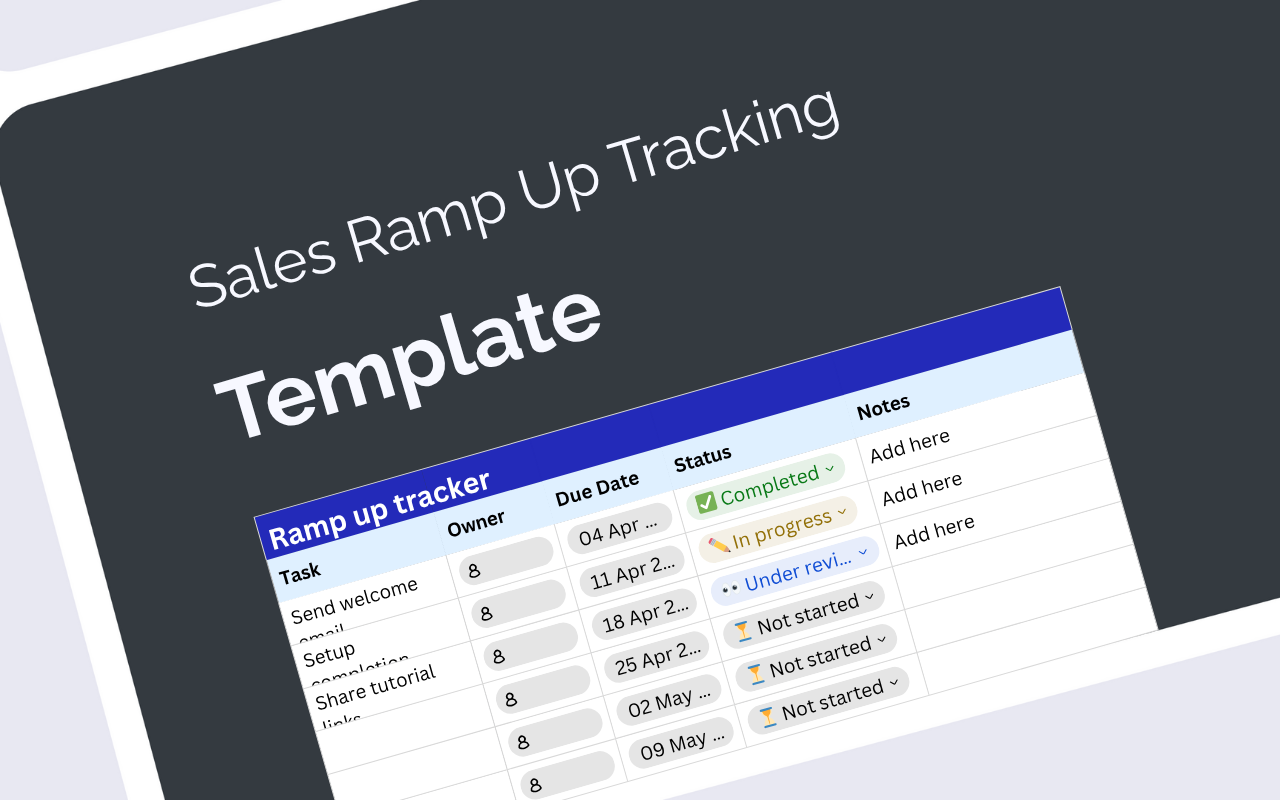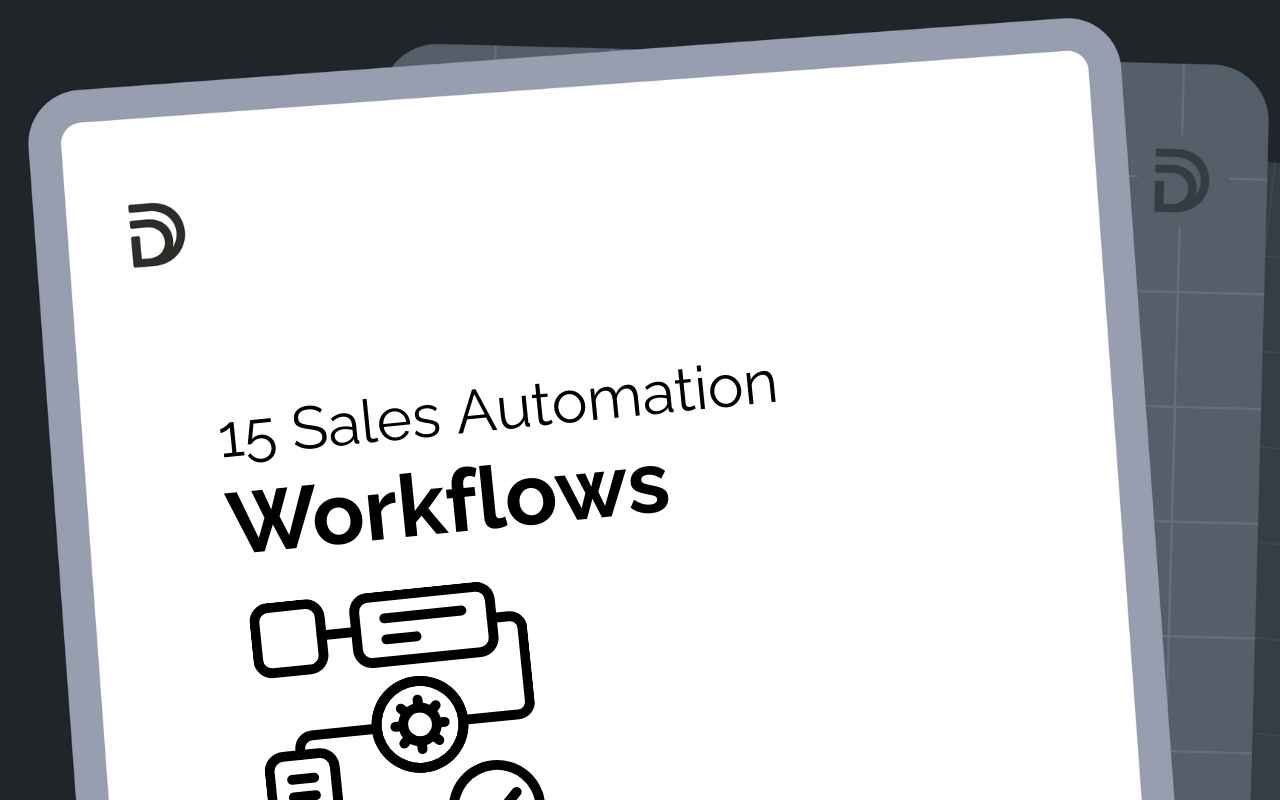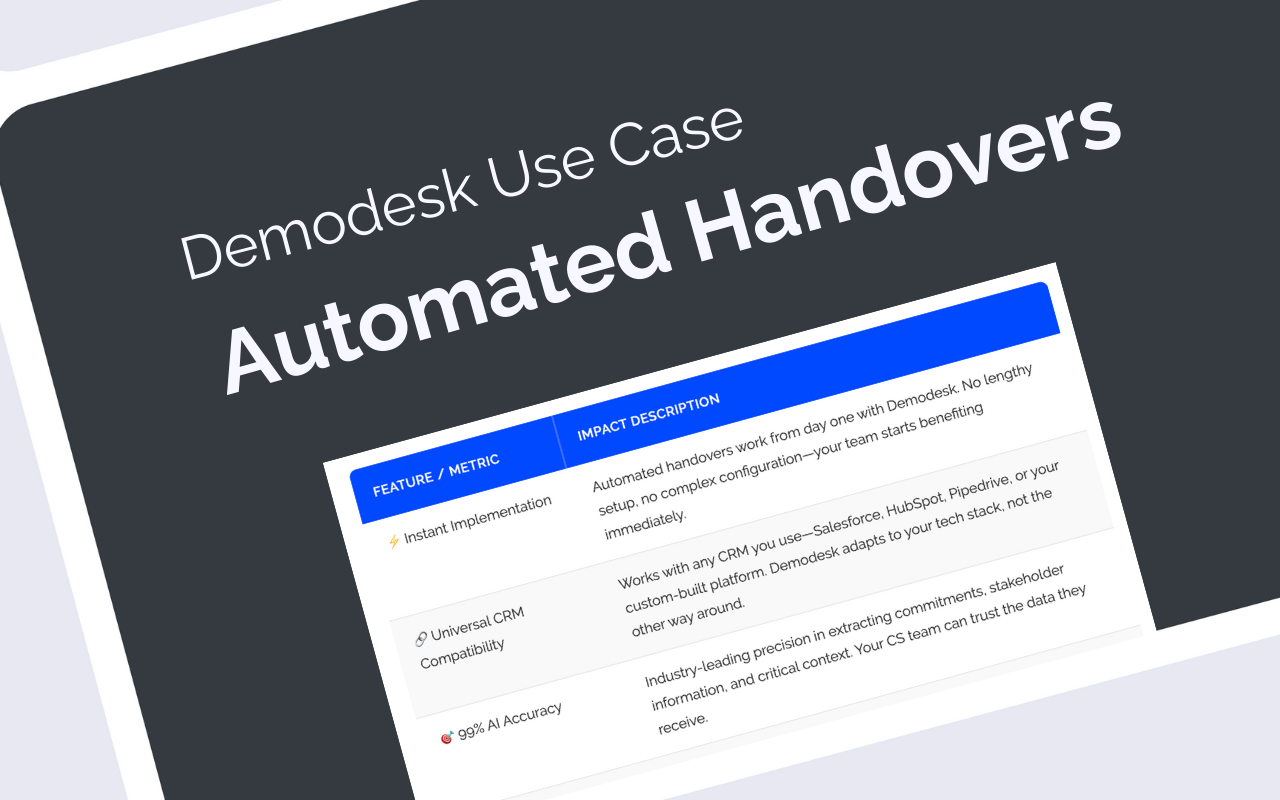Introduction
The success of your sales team directly correlates with how quickly new hires become productive contributors. Yet many organizations struggle to accurately measure, benchmark, and optimize their sales ramp-up process. Without clear visibility into how new hires are progressing, it's impossible to identify bottlenecks, provide targeted coaching, or set realistic expectations for future hires.
This guide shows a systematic, spreadsheet-first way to track ramp in Excel or Google Sheets. If you want the same process to run faster and more accurately, Demodesk automates data capture, ties milestones to real meeting activity, and updates dashboards in real time.
Understanding Sales Ramp-Up: Beyond Time to First Deal
Traditional ramp-up tracking often focuses solely on time to first deal, but this single metric doesn't tell the complete story. Effective ramp-up measurement requires understanding the entire journey from first day to full productivity, including activity levels, skill development, and behavioral patterns that predict long-term success.
A comprehensive ramp-up tracking system monitors both leading indicators (activities, training completion, early engagement metrics) and lagging indicators (deals closed, quota attainment, revenue generated). This dual approach allows managers to intervene early when reps are struggling rather than waiting for poor results to become obvious.
The most successful sales organizations view ramp-up as a measurable business process with clear milestones, benchmarks, and success criteria. This systematic approach not only improves individual outcomes but also provides valuable data for optimizing hiring, training, and coaching programs.
Essential Ramp-Up Metrics to Track
Primary Performance Indicators
Time to First Deal remains a critical benchmark, but it should be measured alongside other milestone achievements. Track the number of days from start date to first closed deal, but also monitor time to first qualified opportunity, first proposal sent, and first customer meeting. These earlier milestones provide leading indicators of ultimate success.
Quota Attainment Progression offers insights into how quickly reps reach full productivity. Measure quota achievement at 30, 60, and 90-day intervals to understand acceleration patterns. Some reps may start slowly but accelerate rapidly, while others might plateau after initial success.
Activity-Based Metrics provide the foundation for all other outcomes. Track meetings held, calls made, emails sent, and proposals generated. These activities are largely within the rep's control and strongly correlate with future results. Establishing activity baselines helps identify reps who may be struggling with time management or prospecting effectiveness.
Conversion and Quality Metrics
Conversion Rate Analysis reveals skill development across the sales process. Monitor lead-to-meeting, meeting-to-demo, demo-to-proposal, and proposal-to-close conversion rates. Tracking these separately helps identify specific skill gaps that can be addressed through targeted coaching.
Meeting Quality Indicators provide insights into relationship-building and discovery skills. Track no-show rates, meeting duration, follow-up meeting scheduling rates, and stakeholder expansion within accounts. High-performing reps typically demonstrate superior meeting quality metrics even early in their tenure.
Scorecard Performance offers objective measurement of call quality, talk ratio, question effectiveness, and customer engagement. These behavioral metrics often predict future success more accurately than activity volume alone.
Process and Milestone Tracking
Key Milestone Achievement helps identify bottlenecks in the ramp-up process. Track completion of training modules, shadowing sessions, first customer-facing activities, and certification achievements. Delays in these areas often predict slower overall ramp times.
Pipeline Development Metrics show how effectively new hires are building their future success. Monitor opportunity creation rate, average deal size, and pipeline velocity. Reps who build strong pipelines early typically sustain higher performance levels.
Building Your Ramp-Up Tracking System
Data Collection Framework
Start by establishing clear definitions for each metric you'll track. What constitutes a "qualified meeting"? When is a deal considered "closed"? How do you define the official start date for ramp-up measurement? Consistent definitions are essential for accurate benchmarking across reps and over time.
Create standardized data collection processes that don't rely on manual input from busy reps. Integrate with your CRM system to automatically capture activity levels, deal progression, and outcome data. Supplement automated data with regular check-ins and qualitative observations from managers and mentors.
Establish data quality standards and regular audit processes. Incomplete or inaccurate data undermines the entire benchmarking system, so invest in systems and processes that ensure data integrity from the beginning.
Excel-Based Tracking Templates
A well-designed Excel template can provide powerful insights without requiring expensive analytics platforms. Create separate worksheets for:
Individual Rep Tracking with columns for each key metric organized by week or month. Include formulas that automatically calculate cumulative totals and compare current performance to benchmarks.
Cohort Analysis that groups reps by start date or hiring class, enabling comparison of ramp-up curves across different time periods or training approaches.
Benchmark Dashboard that shows team averages, top performer metrics, and historical trends. Use conditional formatting to highlight reps who are ahead or behind expectations.
Milestone Tracker that visualizes progress toward key achievements using progress bars or traffic light indicators.
Visual Elements and Reporting
Effective ramp-up tracking goes beyond raw numbers to include visual elements that make patterns and trends immediately apparent. Progress bars show each rep's journey toward full productivity, making it easy to identify who needs additional support.
Trend lines reveal whether reps are accelerating, plateauing, or declining in their development. This information is crucial for timing interventions and adjusting coaching approaches.
Heatmaps can display performance across multiple metrics simultaneously, helping identify patterns in strengths and weaknesses. A rep might excel in activity levels but struggle with conversion rates, suggesting different coaching needs than someone with the opposite pattern.
Establishing Benchmarks and Targets
Historical Analysis
Before setting expectations for new hires, analyze historical performance data to understand realistic timelines and outcomes. Look at your top performers' ramp-up curves to identify achievable but challenging targets.
Consider seasonal variations, market conditions, and product complexity when establishing benchmarks. A rep starting during your busy season may ramp faster due to increased lead flow, while those beginning during slower periods might need different expectations.
Segment your analysis by role, territory, and experience level. A seasoned enterprise rep transitioning from a competitor will likely ramp faster than a college graduate in their first sales role. Adjust expectations accordingly while maintaining consistent measurement standards.
Setting Realistic Expectations
Effective benchmarks balance optimism with realism. Setting targets too high can demoralize new hires, while setting them too low fails to drive necessary urgency. Use your historical data to establish ranges rather than absolute targets, acknowledging that individual circumstances will vary.
Create progressive milestones that build toward full productivity. For example:
- 30 days: Complete training and shadowing, conduct first customer meetings
- 60 days: Generate first qualified opportunities, demonstrate key skills
- 90 days: Close first deals, achieve 50% of quota target
- 120+ days: Reach full productivity and quota expectations
These progressive targets help both managers and reps understand expected development curves and provide clear checkpoints for evaluation and coaching.
Identifying and Addressing Ramp-Up Challenges
Common Bottlenecks
Administrative Burden often slows new hire progress more than skill deficits. Reps who spend excessive time on data entry, system navigation, or internal processes have less time for customer-facing activities that drive results.
Inconsistent Process Adoption creates inefficiencies that compound over time. New hires who don't follow established methodologies for prospecting, discovery, or opportunity management typically struggle with both activity levels and conversion rates.
Insufficient Early Support leaves new hires to figure out complex processes on their own. Without adequate shadowing, mentoring, and feedback, even talented reps may develop bad habits that become difficult to correct.
Warning Signs to Monitor
Watch for specific patterns that indicate potential problems:
Declining Activity Levels after initial enthusiasm often signal frustration with tools, processes, or lack of early success. Address this quickly through additional training and support.
Poor Meeting Quality Metrics such as high no-show rates or short meeting durations suggest issues with prospecting effectiveness or value proposition delivery.
Inconsistent Pipeline Development where reps generate initial activity but fail to advance opportunities through the sales process typically indicates skill gaps in discovery or relationship building.
Intervention Strategies
When tracking reveals reps falling behind benchmarks, implement targeted interventions based on specific gap areas:
Skill-Based Coaching for reps with good activity levels but poor conversion rates. Focus on specific competencies like discovery questioning, objection handling, or proposal development.
Process Optimization for reps struggling with activity levels or administrative efficiency. Streamline workflows, provide better tools training, or assign temporary administrative support.
Mentoring and Shadowing for reps who seem overwhelmed by the complexity of the role. Pair them with high performers for additional learning opportunities.
Advanced Tracking Techniques
Cohort Analysis
Comparing ramp-up performance across different hiring classes reveals insights about training effectiveness, market conditions, and hiring quality. Track multiple cohorts simultaneously to identify trends and validate improvement efforts.
Analyze cohort performance by various factors such as hiring source, background experience, training approach, or assigned territory. This analysis can inform future hiring and onboarding decisions.
Predictive Indicators
Identify early indicators that predict long-term success. Often, behavioral metrics like coachability, question asking frequency, or proactive communication correlate more strongly with future performance than early sales results.
Use these insights to adjust coaching focus and resource allocation. Reps showing strong predictive indicators might benefit from accelerated development opportunities, while those lacking these behaviors need more fundamental skill building.
Cultural and Regional Considerations
For organizations operating across multiple regions or cultures, ramp-up expectations may need adjustment based on local business practices, communication styles, or market dynamics.
Track regional performance separately while maintaining consistent measurement standards. This approach reveals whether differences are due to market factors or execution issues that can be addressed through training or process adjustments.
Technology Integration and Automation
CRM Integration
While Excel provides flexibility for analysis, integrating your tracking system with CRM data ensures accuracy and reduces manual effort. Set up automated data pulls for activity metrics, deal progression, and outcome data.
Use CRM workflows to trigger milestone tracking and coaching alerts. When a rep reaches specific activity levels or time benchmarks, automatically notify managers and generate coaching recommendations.
Automated Reporting
Create automated reports that update weekly or monthly, providing consistent visibility into ramp-up progress. Include both individual performance data and team-level trends to support different management needs.
Set up exception reporting that highlights reps who are significantly ahead or behind expectations, enabling proactive coaching and support.
AI and Analytics Enhancement
Consider integrating conversation intelligence tools that can provide objective feedback on call quality, talk ratio, and engagement levels. This data supplements traditional metrics with behavioral insights that predict success.
Use analytics to identify patterns in successful ramp-up journeys, then incorporate these insights into training and coaching programs for future hires.
Creating a Culture of Ramp-Up Excellence
Manager Accountability
Establish clear expectations for managers regarding new hire development. Track manager effectiveness by measuring the ramp-up success of their new hires compared to organizational benchmarks.
Provide managers with tools and training to effectively use ramp-up data for coaching conversations. Data without context and actionable insights doesn't drive improvement.
Peer Learning Programs
Create structured programs where successful reps share their ramp-up experiences with new hires. This peer learning approach provides practical insights that supplement formal training programs.
Develop libraries of best-practice examples, recorded calls, and success stories that new hires can reference during their development journey.
Continuous Improvement
Regularly review and update your tracking system based on changing business needs, market conditions, and organizational growth. What worked for a 10-person sales team may not scale to 100 people.
Gather feedback from both new hires and managers about the tracking process itself. Streamline data collection, improve reporting clarity, and adjust metrics based on practical experience.
Implementation Roadmap
Phase 1: Foundation (Weeks 1-2)
- Define key metrics and measurement standards
- Create Excel templates and data collection processes
- Establish baseline benchmarks from historical data
- Train managers on tracking system usage
Phase 2: Deployment (Weeks 3-4)
- Begin tracking current new hires using the system
- Implement regular reporting schedules
- Start using data for coaching conversations
- Gather initial feedback and make adjustments
Phase 3: Optimization (Months 2-3)
- Analyze first cohort results and refine benchmarks
- Identify successful intervention strategies
- Expand tracking to additional metrics or teams
- Integrate with existing systems where possible
Phase 4: Scale and Refine (Ongoing)
- Use tracking insights to improve hiring and training
- Develop predictive models for ramp-up success
- Share best practices across the organization
- Continuously update benchmarks and targets
Measuring System Success
Key Performance Indicators
Track the effectiveness of your ramp-up tracking system through several key metrics:
Reduction in Average Ramp Time as processes and coaching improve based on data insights.
Improved Prediction Accuracy for new hire success, enabling better hiring and support decisions.
Increased Manager Confidence in coaching and development conversations, supported by objective data.
Enhanced New Hire Experience as tracking enables more targeted support and clearer expectations.
Return on Investment
Calculate the business impact of improved ramp-up tracking through reduced time to productivity, higher new hire retention rates, and improved overall team performance. Even modest improvements in ramp-up speed can generate significant revenue impact over time.
Conclusion
Effective sales ramp-up tracking transforms new hire development from an art into a science. By systematically measuring key metrics, establishing realistic benchmarks, and using data to drive coaching decisions, organizations can significantly improve their new hire success rates while reducing the time and effort required to achieve full productivity.
The Excel-based approach outlined in this guide provides a practical starting point that can evolve with your organization's needs. Whether you're managing your first new hire or optimizing an established onboarding program, these frameworks will help you make data-driven decisions that improve outcomes for both new hires and the organization.
Remember that the goal isn't perfect tracking but rather consistent improvement. Start with the most important metrics, build reliable processes, and gradually expand your system as you gain experience and insights. The investment in systematic ramp-up tracking will pay dividends through improved hiring decisions, more effective coaching, and ultimately, stronger sales performance across your entire organization.
Quick Start Checklist
- [ ] Define key metrics and measurement standards for your organization
- [ ] Create Excel templates for individual tracking and cohort analysis
- [ ] Establish baseline benchmarks using historical performance data
- [ ] Train managers on system usage and coaching applications
- [ ] Begin tracking current new hires and generate first reports
- [ ] Schedule regular review meetings to discuss progress and interventions
- [ ] Gather feedback and refine the system based on initial experience
- [ ] Plan for system expansion and integration with existing tools
Success in sales ramp-up tracking comes from consistent application and continuous refinement. Start simple, measure what matters, and use the insights to drive meaningful improvements in your new hire development process.










